Ethiopia, in the Horn of Africa, is a rugged, landlocked country split by the Great Rift Valley.
With a landscape that ranges from rainforests, to grassy savannas, mountains, and deserts, Ethiopia boasts scenery that is as diverse and fascinating as its people. This variety of habitat has resulted in an impressive array of wildlife including over 850 species of birds, many extremely beautiful and exotic.
With archaeological finds dating back more than 3 million years, it’s a place of ancient culture. Among its important sites are Lalibela with its rock-cut Christian churches from the 12th–13th centuries. Aksum is the ruins of an ancient city with obelisks, tombs, castles and Our Lady Mary of Zion church.
At the crossroad of ancient trade routes, and one of the world’s oldest nations, amazingly Ethiopia was never colonized.
Unique cultures, natural beauty, amazing history, wonderful people: there are many reasons to visit Ethiopia.

Explore Ethiopia:
- Lalibela – churches carved out of solid rock
- Omo Valley – indigenous tribes
- Harar – ancient walled Islamic city
- Danakil Depression – Erta Alle volcano, lowest point on African Continent
- Simien Mountains – the rooftop of Africa and home to Gelada Baboon
- Rock Churches of Tigrai – beautiful and remote
- Bale Mountains – great trekking; endemic wildlife, Ethiopian Red Wolf
- Axum – heart of an African empire
- Gondar – home to Ethiopian kings
- Lake Tana – source of the Blue Nile
- . . . and injera flat bread, Timkat Festival, shoulder-dancing, coffee ritual, tej honey wine, . . .
Three of the world’s great religions have deep roots in Ethiopia:
- Jews came to Ethiopia during the time of King Solomon.
- Christianity was officially recognized during the 4th century.
- The first mosque outside the Arabian Peninsula was built in Ethiopia.
Climate
Although it’s near the equator, much of Ethiopia’s climate is very pleasant due to the high altitude. In the Ethiopian highlands (the historic north route), temperatures average between 15˚C (60˚F) and 27˚C (80˚F). However, temperatures can get surprisingly cool at night. In the south (Omo Valley tours) temperatures can approach 32˚C (90˚F). For trekking in either the Simien Mountains or Bale Mountains, you should be prepared for cold nights so be sure to bring clothes you can “layer” on as you need them.
- For most of Ethiopia, the rains are more frequent in June, July, and August.
- The rainy season in the south (Omo Valley) is in April and May.
- We do not travel to the Afar (Danakil Depression) region from late May until mid September due to the very high temperatures.
- We do not offer treks in the Simien Mountains and Bale Mountains from June until early September due to the rains.
For suggested itineraries please see HERE and click Ethiopia.
Addis Ababa, Ethiopia’s sprawling capital in the highlands bordering the Great Rift Valley, is the country’s commercial and cultural hub. Its National Museum exhibits Ethiopian art, traditional crafts and prehistoric fossils, including replicas of the famous early hominid, “Lucy.”
Lalibela is a town in the Amhara region of northern Ethiopia. It’s known for its distinctive rock-cut churches dating from the 12th and 13th centuries, which are pilgrimage sites for Coptic Christians. This group of eleven monolithic and semi-monolithic structures was carved directly into the stone of the mountainside at least 800 years ago. With the largest monolithic church in the world; a maze of passageways and tunnels; intricately carved reliefs; and fabulous examples of icon paintings; the Lalibela churches were built by carving a massive rectangular trench around a solid stone block. This solid block was then hollowed out, leaving interior columns, windows, reliefs, etc. Other churches were carved in a similar fashion but leaving either one side or the roof attached to the surrounding stone. Not only the craftsmanship but also the sheer size of the churches is stunning. Medhane Alem, the largest, sits on 800 square meters and St. George is 15 meters deep.
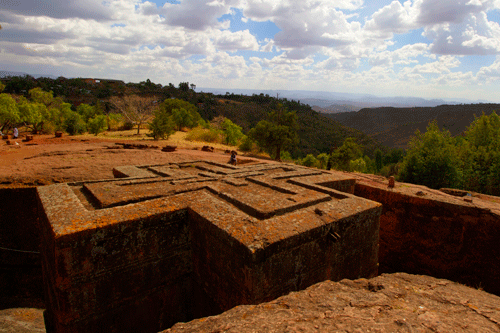
The ancient and hand-written texts held in almost every church were written in “Geez,” the language of the Ethiopian Orthodox Church. A semitic language, Geez is is the forerunner of modern day Amaharic.
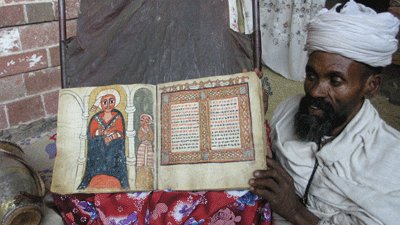
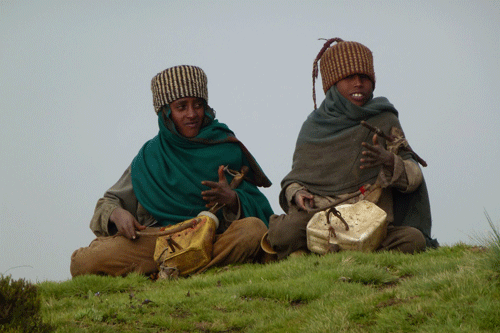
Simien Mountains National Park is one of the national parks of Ethiopia. Located in the Semien Gondar Zone of the Amhara Region, its territory covers the Semien Mountains and includes Ras Dashan, the highest point in Ethiopia at 14,928 feet. It is home to a number of endangered species, including the Ethiopian wolf and the walia ibex, a wild goat found nowhere else in the world. The gelada baboon and the caracal, a cat, also occur within the Simien Mountains. More than 50 species of birds inhabit the park, including the impressive bearded vulture, or lammergeier, with its 3 m wingspan.
The park offers spectacular trekking opportunites including ascents of Ras Dashen. Treks into the park include all camping equipment and supplies and are accompanied by a mountain guide, camp cook, park scout, and pack animals. Africa’s highest lodge is located inside the park and a new lodge has recently opened nearby. The unique beauty and dramatic landscapes in the Park have earned it recognition as a UNESCO World Heritage site.
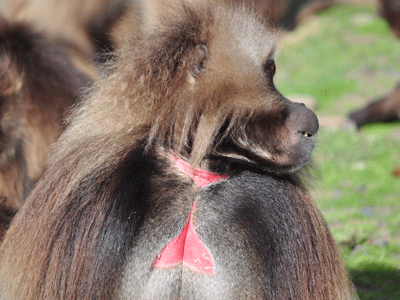
Bahir Dar is the capital city of the Amhara region in northern Ethiopia. It’s a port on the south shore of the huge inland Lake Tana and close to the beautiful Blue Nile Falls. Dek Island is one of many islands in the lake that are home to medieval monasteries. On the Zege Peninsula, the Ura Kidane Mihret monastery is known for its elaborate, colorful murals.
Gondar is a city in northern Ethiopia. It’s known for the walled Fasil Ghebbi fortress and palace compound, once the seat of Ethiopian emperors. Dominating it is the immense 17th-century castle of Emperor Fasilides, which combines Portuguese, Indian and local architectural styles. A succession of Ethiopian kings built castles, also known as the “Royal Enclosure or “Fasil Ghebbi” that still occupy the modern day Gondar. It is recognized as a UNESCO World Heritage site.
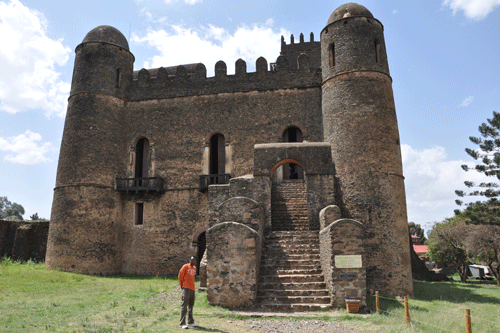
This region was once home to the “Felasha”, or Ethiopian Jews, who emigrated en masse to Israel in the late 20th century. Although only a few remain, their influence is still seen in the symbols, customs, and rituals of the Ethiopian Orthodox Church.
The Omo River Valley in southern Ethiopia is undoubtedly one of the most unique regions in the world. Within this small geographic area reside at least 30 distinct ethno-linguistic groups, whose lifestyles, until very recently, did not vary much from those of their ancestors. Elaborate body painting, scarification, women with clay lip plates, elaborate headdresses of clay and feathers help distinguish one tribe from one another. This part of Ethiopia, extending into northern Kenya, is incredible for both its cultural diversity and the isolation of its inhabitants for centuries past.
As influences from the outside world inevitably encroach on this fascinating land, the people of the Omo Valley will face many challenges regarding their culture and way of life.

One of the best ways to meet and learn about the various tribes is to wander through one of the weekly markets where various tribes gather to trade and barter. The Thursday market in Key Afar and the Tuesday market at Alduba are among the most interesting.
The Dorze tribe: – A rich weaving tradition
They are one of the small segments of the great Omotic language group of southern Ethiopia. Once warriors, they now earn their living by farming and weaving. The Dorze name is synonymous with the best in woven cotton cloth and the tall-up bee-hive shaped bamboo house. There is quite a big Dorze community living and weaving on the northern part of Addis, on the way to Entoto. These peoples rarely use the administrative and police force of the city. They settle all disputes in their usual cultural way, through their elders.
Konso: – People of Wooden-totem
About 960 miles south west of Addis Ababa lies the widely cultivated Konso land that is embraced by Precambrian serpentines and granites. The Konso peoples speak eastern Cushitic language and are agriculturalists and weavers. These peoples are cryptic beyond visitors’ imagination which is demonstrated in the distinctive idealization of the figures and heroic lives of their deceased symbolized with wooden totem.
Hamar & Benna: – the Bull-Jumping people
Inscribed in the far South West Omotic region, beyond Mount Buska live the Hamar and Benna people. These astounding and superstitious people, were veiled in mystery for over half a century. The Hamar and Benna, are two of the Omotic speakers of remote south west Ethiopia, with unique manifestations of traditional wisdom, the ‘jumping of bulls’. The purpose of this rite is two fold: while one is the passage from boyhood to adulthood, the other is the courting occasion when both men and women adorn themselves to win a mate. The men put an ochre buns on their skin and head and insert ostrich feather, while the women wear their hair in short tufts rolled in ochre mixed with fat.
Mursi & Surma: – people of labial and lobular plates
In the remote wilderness of the south west Ethiopia live the Mursi & Surma. These peoples were completely forgotten by Ethiopia and the outside world at large, and they on their part had no notion of the outside world including Ethiopia until the seventies. The peoples of this savannah and mountainous land have such extensive cultural features that never ceases to amaze visitors. While the women show their beauty and endurance by the ear lobes and the piercing of the lips, the men demonstrate their courage and stamina in the stick fighting ceremony.
The Karo tribes: – people of chalk painted bodies
The Karo tribe residing along the borders of the Lower Omo River incorporates rich, cultural symbolism into their rituals by using ornate body art, intricate headdresses, and significance within their community. The most important ceremony in the life of a Karo is the Pilla, or jumping over a group of oxen. This ritual marks the passage from adolescence to adulthood. The ceremony is similar to that of the Hamar, however the Karo only have four chances to jump over the oxen without falling.
The Dassanetch: – people of circumcision
They speak a completely different language and are actually the Cushitic speaking group of the Omo Valley. The most important ritual of the Dassanetch is the so-called dime. In theory, only a man who has had a daughter can be circumcised, although in practice, circumcision is carried out on the entire age-group. The daughter is most important in the dime ceremony. After the ceremony, which takes six weeks, the participants are upgraded to ‘great men’, or those that may engage in politics. The dime ritual is directly connected to the upcoming marriage of the daughter when large quantities of cattle are slaughtered for the occasion.
Once the hub of a great civilization that spread from East Africa, across the Red Sea, and into the Arabian Peninsula, Axum is home to some of the most significant archeological findings on the entire continent. Ethiopian and foreign scholars working in the region believe they’ve only hit the tip of the iceberg of artifacts and ruins waiting to be discovered.
The most obvious of Axum’s ancient wonders are the huge stelae erected over 1,700 years ago. These massive pieces of solid stone were hauled four kilometers from a quarry, carved into obelisks, and then raised upright. How the Axumites were able to achieve such technological marvels remains a mystery. The tallest stele is 23 meters (75 feet) high, while one which lays shattered is 33 meters in length and weighs a staggering 500 tons.
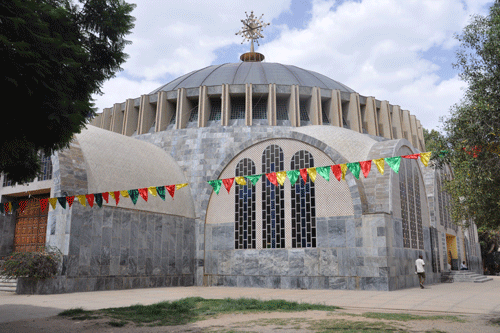
With more than 30 active and dormant volcanoes, the Danakil Depression is one of the most unique geological regions on earth. A strange and mysterious landscape – scattered with noxious hot springs, frozen black-lava flows, and massive salt basins left over from ancient lakes – it is one of the most tectonically active places on the planet In stark contrast to the cool, temperate Ethiopian highlands, it is also one of the lowest, driest, and hottest places on earth. The lowest point (155m/509 ft below sea level) on the African continent, the Danakil is where the famous 32.million year old fossil hominid “Lucy” was discovered in 1974. A trip to the Danakil is full of adventure and surely one you will never forget.
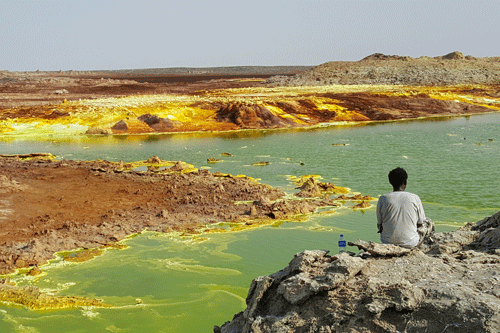
NOTE: A trip to the Afar region should only be undertaken with proper planning and a knowledgeable guide. With an average annual temperature of 34-35º C, abundant supplies of water should be taken along. With a knowledgeable guide, up-to-date information from embassies in Addis Ababa, and a well-planned trip, a safe tour can be taken to the region
 English
English Deutsch
Deutsch











